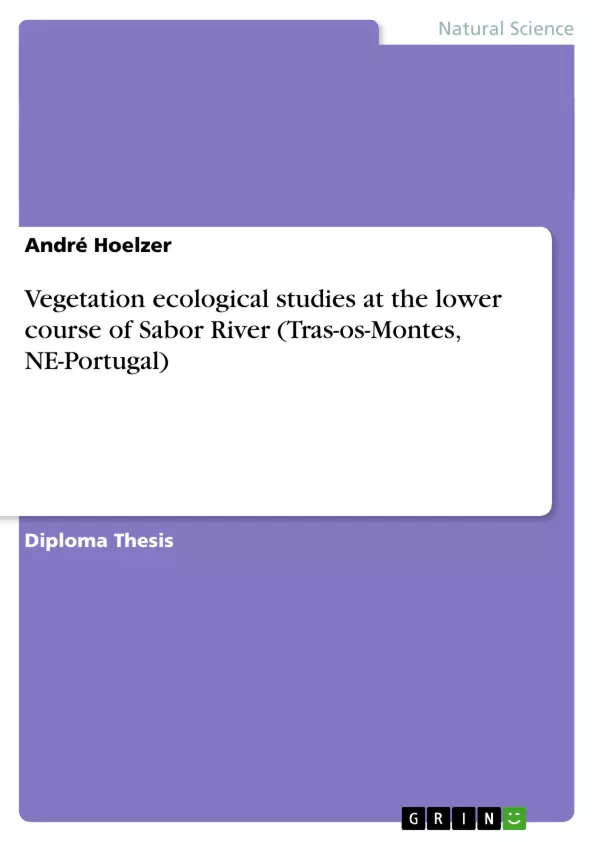A vegetation ecological study was conducted at the lower course of Sabor river, northeastern Portugal. The valley of this river constitutes an agroecosystem with typical Mediterranean traits and is known for its diversity of habitats with conservational value. The valley suffered from considerable abandonment of agricultural areas over the past four decades, whereas the extension of not intervened vegetation increased substantially. However, the whole extension of the lower course of this river is endangered by the construction of a hydroelectric power plant, and submersal of huge areas will be an immediate impact. In order to characterize the floristic-structural dynamics and diversity of the vegetation covering the valley, representative samples of different communities at different altitudes along the river valley were taken. In all, 109 relevés with an homogeneous area of 10 x 10 m2 comprised a section of the river with an extension of 30 km. Samples were classified into distinct types of communities, according to their structure: riparian communities, rupicolous communities, scrublands, woodlands and grove communities. Two basic approaches were applied to examine the ecology of vegetation. First, the total species numbers within the different samples were compared. Riparian communities proved to be the richest in terms of species, and species numbers were higher than 60/100 m2 in several cases. A strong concentration of diversity coincided with the immediate riverside zone, whereas other environmental factors did not explain significantly the concentration of species. The communities subjected to agricultural intervention were the second richest community type in terms of species numbers. By far the highest percentage of all registered species pertained to a therophytic life form.
Inhaltsverzeichnis (Table of Contents)
- 1. Introduction
- 2. Methodology
- 2.1 Study area
- 2.1.1 General considerations
- 2.1.2 Topography
- 2.1.3 Climate
- 2.1.4 Hydrology
- 2.1.5 Geology
- 2.1.6 Soils
- 2.1.7 Bioclimatic description
- 2.1.8 Biogeography and Vegetation
- 2.1.9 Land use
- 2.2 Sampling
- 2.3 Data analysis
- 2.3.1 Species richness
- 2.3.2 Floristic-structural analysis
- Arrangement of basic structural matrices
- Arrangement of contingency matrices
- Cluster analysis
- Ordination by Principal Component Analysis
- Discriminant Canonical Analysis
- Assessment of intensity of land use
- 2.1 Study area
- 3. Results
- 3.1 Species richness
- 3.2 Floristic-structural analysis
- Cluster analysis with BSM
- Ordination by PCA
- Correlation Clusters (Tendencies of Behaviour)
- Life form, frequency classes and expressivity in apparent communities
- Discriminant analyses
- Assessment of land use intensity
- 4. Discussion
- 4.1 Species richness
- 4.2 Floristic-structural analysis
- 5. Literature cited
Zielsetzung und Themenschwerpunkte (Objectives and Key Themes)
This diploma thesis examines the vegetation ecology of the lower course of the Sabor River in northeastern Portugal. The study focuses on characterizing the floristic-structural dynamics and diversity of the vegetation covering the valley, particularly in the context of land-use changes and the potential impact of a planned hydroelectric power plant.
- Characterizing the floristic-structural dynamics and diversity of the vegetation
- Assessing the influence of land-use changes on vegetation patterns
- Analyzing the potential impact of the hydroelectric power plant on the riverine ecosystem
- Examining the ecological significance of riparian communities
- Exploring the role of structural parameters in describing vegetation structure
Zusammenfassung der Kapitel (Chapter Summaries)
Chapter 1 provides an introduction to the study, outlining the ecological significance of the Sabor River valley and the motivation behind the research.
Chapter 2 details the methodology employed in the study, encompassing the study area description, sampling techniques, and data analysis methods. This chapter includes detailed information about the geographical, climatic, and hydrological characteristics of the region, as well as the specific methods used for data collection and analysis.
Chapter 3 presents the results of the study, encompassing the species richness analysis and the floristic-structural analysis based on multivariate statistical techniques. The chapter provides insights into the species composition, structural characteristics, and spatial distribution of the vegetation communities.
Chapter 4 discusses the results obtained, relating the findings to existing knowledge about the vegetation ecology of the region and offering interpretations of the observed patterns. The chapter addresses the ecological significance of the findings and their implications for the conservation and management of the Sabor River valley.
Schlüsselwörter (Keywords)
This diploma thesis focuses on vegetation ecology, riparian communities, floristic-structural dynamics, diversity, land-use change, hydroelectric power plant, and multivariate statistical analysis. The study utilizes a combination of field observations, species richness analysis, and structural parameters to explore the vegetation patterns and their ecological implications.
- Arbeit zitieren
- André Hoelzer (Autor:in), 2003, Vegetation ecological studies at the lower course of Sabor River (Tras-os-Montes, NE-Portugal), München, GRIN Verlag, https://www.grin.com/document/28444



